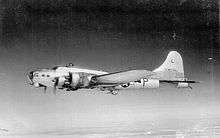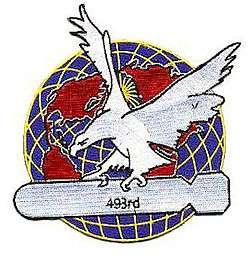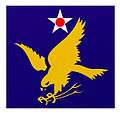493d Bombardment Group
| 493d Bombardment Group | |
|---|---|
|
493d Bombardment Group Insignia | |
| Active | 1942–1946 |
| Country | United States |
| Branch | United States Army Air Forces |
| Role | Bombardment |
| Part of | Eighth Air Force |
| Garrison/HQ | European Theatre of World War II |


The 493d Bombardment Group is an inactive United States Army Air Forces unit. Its last assignment was to the Army Service Forces, being stationed at Sioux Falls Army Air Field, South Dakota. It was inactivated on 28 August 1945.
During World War II, the group was an Eighth Air Force heavy bombardment unit in England, stationed at RAF Debach. The group flew its last combat mission, an attack on marshalling yards at Nauen, on 20 April 1945.
History
Established in September 1943 as a B-24 Liberator heavy bombardment group, being activated on 1 November at McCook Army Airfield, Nebraska. The 493d was one of seven Heavy Bombardment Groups – 488th through 494th – activated in the autumn of 1943. These were to be the last Army Air Forces heavy bomb groups established.
The origins of the 493d Bomb Group begin as the 13th Antisubmarine Squadron, then retraining as a heavy bombardment unit in B-24s in Pueblo Army Air Base, Colorado. At Pueblo, the unit became identified as the 493rd Bombardment Group and moved to Davis-Monthan Army Air Field, near Tucson, Arizona for additional training. The Arizona crews joined other personnel already assembled in McCook in mid-January 1944. Additional officers and men, chiefly from the 34th Bombardment Group training at Blythe Army Air Base, California, were assigned to the Group in February and March. Intensive training of all airmen and support specialists began in January and was only occasionally interrupted by Nebraska's late winter and early spring storms. Air exercises in several models of B-24s included day and night flights, cross-country navigation, simulated bombing, aerial-gunnery practice, and squadron and group formation flying.
Was deployed to the European Theater of Operations (ETO), being assigned to VIII Bomber Command in England. The 493d was transferred without men or equipment. A ground echelon, staffed with personnel from groups of the VIII Bomber Command 3d Bombardment Division in England was reassigned to RAF Debach, in April 1944. A ground contingent with some aircrew left McCook by train on 2 May for Camp Miles Standish, Massachusetts, and sailed from Boston on the USS Brazil on 12 May, landed at Liverpool on 26 May, and arrived at RAF Debach the following day. Aircrews left McCook in early May and flew the northern transport route to the U.K.; via New Hampshire, Labrador, thence to Debach by way of Iceland and Wales, or by way of Northern Ireland. The group was stationed at Debach until the end of the European War in 1945, with a temporary move to RAF Wormingford in early 1945 while runways were being repaired at Debach.
The 493rd Bomb Group was the last group to become operational in the Eighth Air Force. The 493rd was assigned to the Third Air Division, 93rd Wing of the VIII Bomber Command on 1 January 1944. Command assignments made in April were to the Third Bomb Division, 93rd Combat Bomb Wing. The Group was composed of the 860th, 861st, 862nd, and 863rd Heavy Bombardment Squadrons. (The 862nd Squadron was established as Third Scouting Force on 1 February 1945. Ground personnel transferred, but aircraft and crews were assigned to the other squadrons. The 862nd rejoined the Group in May.) The group tail code was a "Square-H".
The Group was quartered at Debach except for a temporary move of the air echelon in March 1945 to Station 165, Little Walden, Essex County while runways at Debach were repaired. Combat aircraft included B-24Hs and B-24Js from 6 June to 24 August 1944, and B-17Gs from 8 September 1944 to 20 April 1945.
The 493d BG used B-24's until they were replaced with B-17's in September 1944. The group operated chiefly against industrial and military installations in Germany, attacking an ordnance depot at Magdeburg, marshalling yards at Cologne, synthetic oil plants at Merseburg, a railroad tunnel at Ahrweiler, bridges at Irlich, factories at Frankfurt, and other strategic objectives.
Additional operations included striking airfields, bridges, and gun batteries prior to and during the invasion of Normandy in June 1944; hitting enemy positions to assist ground forces south of Caen and at Saint-Lô in July 1944; bombing German fortifications to cover the airborne attack on the Netherlands in September 1944; attacking enemy communications during the Battle of the Bulge, December 1944 – January 1945; and assisting the airborne assault across the Rhine in March 1945. The 493d Bomb Group flew its last combat mission, an attack on marshalling yards at Nauen, on 20 April 1945.
The Group redeployed to the United States. in July and August 1945. Aircraft and crews began taking off for the last time from Debach on 30 June. The ground echelon sailed home on the Queen Elizabeth on 6 August and debarked in New York on 11 August. All personnel were granted a 30-day leave. The Group was established at Sioux Falls Army Air Field, South Dakota on 12 August, however the Japanese Capitulation negated the need for the unit to train in B-29s and re-deploy to the Pacific Theater. The personnel were demobilized and the unit was inactivated there on 28 August 1945.
Lineage
- Constituted as 493d Bombardment Group (Heavy) on 14 September 1943
- Activated on 1 November 1943
- Inactivated on 28 August 1945
Assignments
- Second Air Force, 1 November 1943
- Eighth Air Force, 1 January 1944
- 93d Combat Bombardment Wing, April 1944-6 August 1945
- Army Service Forces (for inactivation), 12–28 August 1945
Components
- 860th Bombardment Squadron (NG), 1 November 1943 – 28 August 1945
- 861st Bombardment Squadron (G6), 1 November 1943 – 28 August 1945
- 862d Bombardment Squadron (8M), 1 November 1943 – 28 August 1945
- 863d Bombardment Squadron (Q4). 1 November 1943 – 28 August 1945
Stations
- McCook Army Airfield, Nebraska, 1 Nov 1943 – 1 Jan 1944
- RAF Elvedon Hall (AAF-116), England, 1 Jan 1944
- RAF Debach (AAF-152), England, 17 Apr 1944
- RAF Wormingford (AAF-159), England, 17 Feb 1945
- RAF Debach (AAF-152), England, 18 May-6 Aug 1945
- Sioux Falls Army Air Field, South Dakota, c. 13–28 Aug 1945
Aircraft flown
- B-24 Liberator, 1943–1944
- B-17 Flying Fortress. 1943–1945
References
![]() This article incorporates public domain material from the Air Force Historical Research Agency website http://www.afhra.af.mil/.
This article incorporates public domain material from the Air Force Historical Research Agency website http://www.afhra.af.mil/.
- Freeman, Roger A. (1978) Airfields of the Eighth: Then and Now. After the Battle ISBN 0-900913-09-6
- Freeman, Roger A. (1991) The Mighty Eighth: The Colour Record. Cassell & Co. ISBN 0-304-35708-1
- Maurer, Maurer (1983). Air Force Combat Units Of World War II. Maxwell AFB, Alabama: Office of Air Force History. ISBN 0-89201-092-4.
External links
| Wikimedia Commons has media related to 493d Bombardment Group. |

